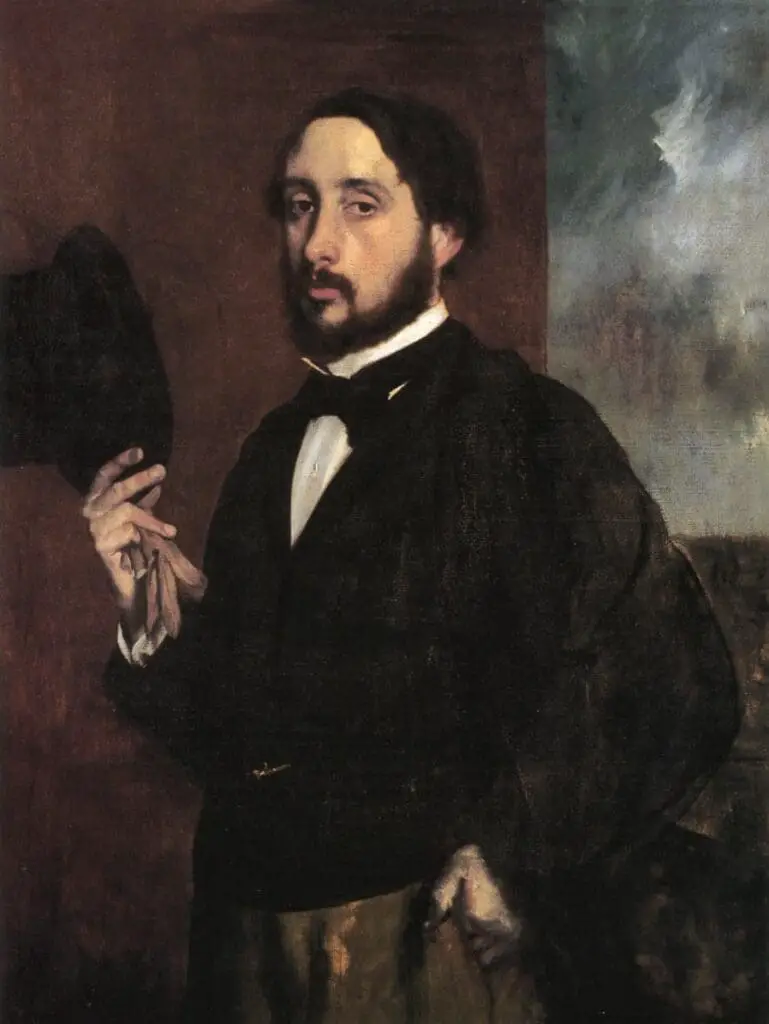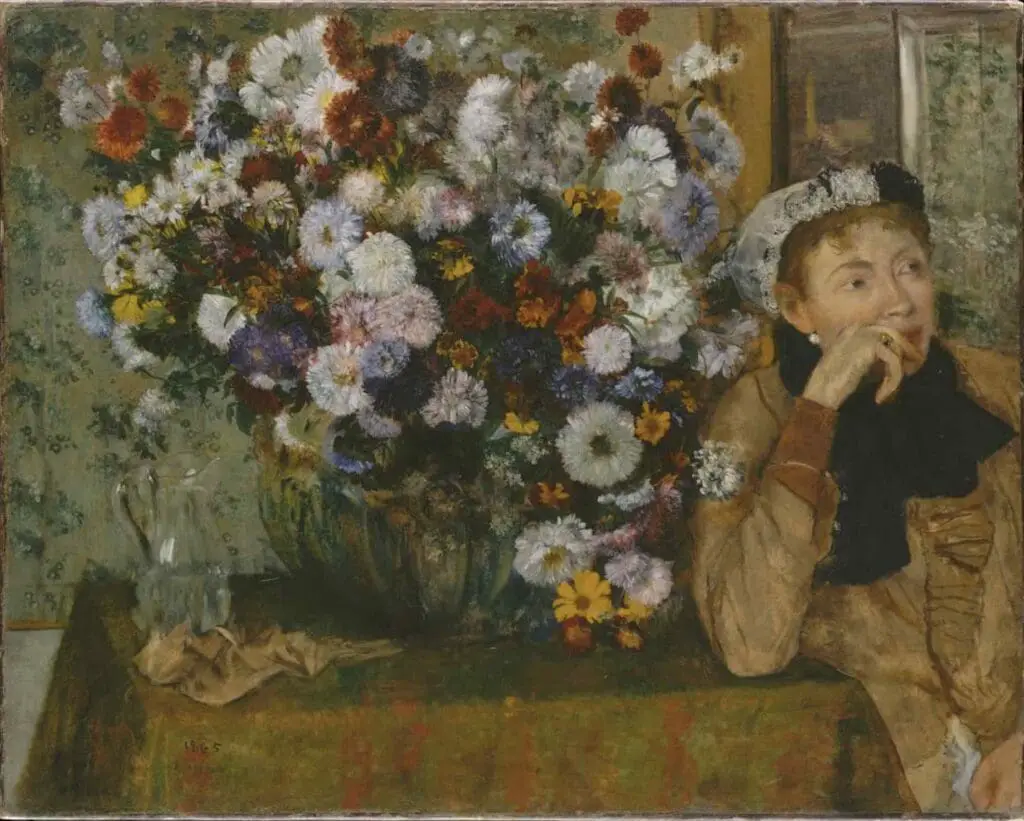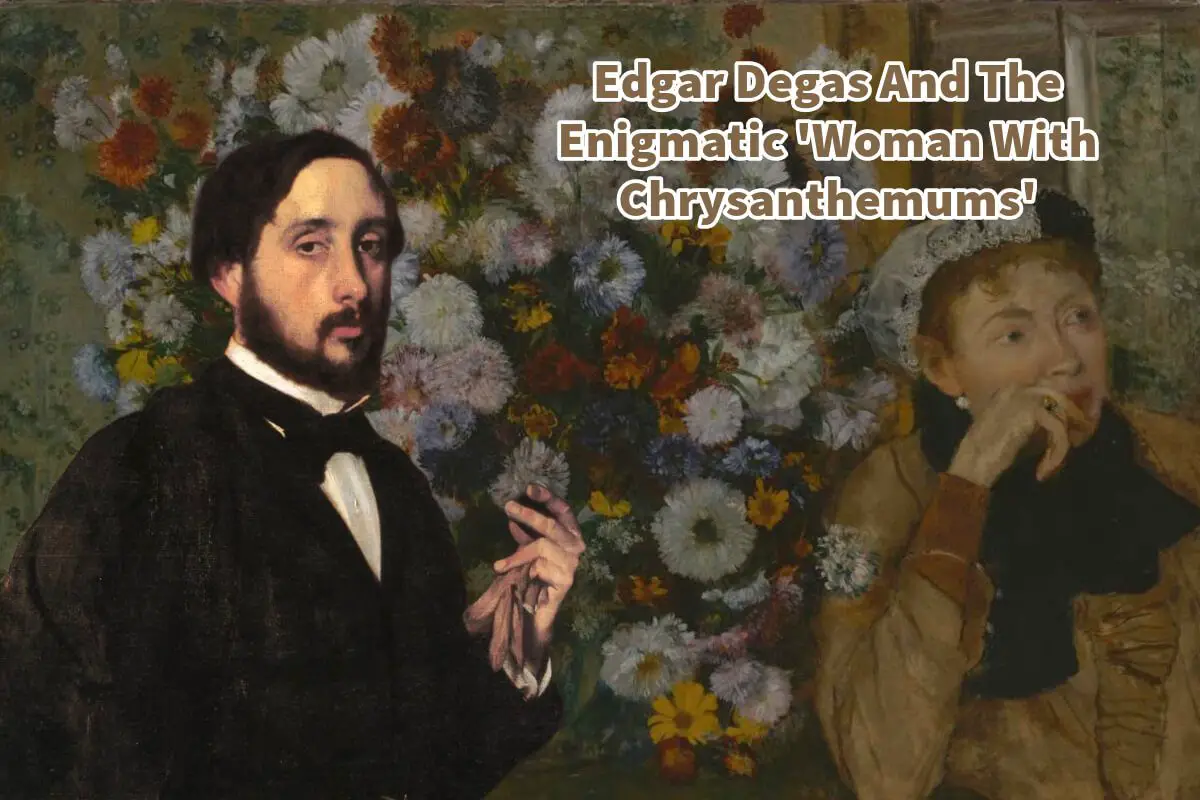Edgar Degas is one of the greatest artists that ever lived. One of his most fabulous paintings by Edgar Degas is Woman With Chrysanthemum.
The painting ‘Woman with Chrysanthemums’ is a quintessential illustration of Edgar Degas’ artistic genius, epitomizing his innovative approach, emotional depth, and unparalleled craftsmanship. Continue reading to delve deeper into why Edgar Degas remains an iconic artist and to explore the enigmatic allure of ‘Woman with Chrysanthemums.’
Table of Contents
- Edgar Degas And The Enigmatic ‘Woman With Chrysanthemums’: An Exploration Of The Artistic Importance
- The Importance Of ‘Woman With Chrysanthemums’ By Edgar Degas
- Frequently Asked Questions
- Related Questions
Edgar Degas And The Enigmatic ‘Woman With Chrysanthemums’: An Exploration Of The Artistic Importance
In art, few names evoke as much reverence as Edgar Degas. Born in 1834, this French artist became a towering figure in Impressionism.
Although he rejected the label himself, preferring to be known as a realist, his contributions to the Impressionist movement are undeniable. Among his vast portfolio of masterpieces, the painting ‘Woman with Chrysanthemums’ is a testament to his innovative techniques, depth of expression, and extraordinary skill.
A Brief History Of Edgar Degas
Edgar Degas, born Hilaire-Germain-Edgar De Gas, hailed from a well-to-do family in Paris, France. He displayed an early affinity for the arts, mainly drawing.

Though he began his artistic journey in the traditional realm, studying under the academic artist Louis Lamothe, Degas soon broke away from the constraints of conventional styles. With a law degree and no shortage of family wealth to cushion him, he had the freedom to experiment with his art.
Degas explored multiple artistic mediums during his lifetime, including oil painting, pastels, and sculpture. He would become best known for his depictions of ballet dancers, capturing the nuances of their movements with unparalleled grace.
But beyond this subject, he was also a chronicler of modern life—capturing laundresses, milliners, and café scenes.
The Importance Of ‘Woman With Chrysanthemums’ By Edgar Degas

Created in 1865, the ‘Woman with Chrysanthemums’ is a striking example of Degas’ aptitude for capturing the subtleties of emotion and environment. The painting features a young woman, presumed to be a Parisian socialite, surrounded by a bouquet of vivid chrysanthemums.
Her expression is hard to decipher: it could be one of melancholy, contemplation, or quiet joy. This ambiguity intrigues the painting and keeps viewers returning for multiple glances.
Composition And Technique Of Edgar Degas
At first glance, one might notice that Degas’ composition adheres to a traditional form: a portrait layout featuring a female subject in an interior space. However, upon closer inspection, his inventive touches come to light.
The artist is masterful in his use of space, placing the woman offset, neither perfectly centered nor leaning too heavily to one side. This strategic composition allows for a generous display of chrysanthemums, their vibrancy contrasting against the darker backdrop and making them almost as much of a subject as the woman herself.
Technically speaking, Degas’ handling of oils shows his mastery of the medium. The interplay of light and shadow across the subject’s face, her gown, and the bouquet reveal his fine-tuned skills.
He employs shorter, quick brushstrokes that would later become associated with the Impressionist movement, enabling him to capture the fleeting qualities of light and color.
Symbolism And Themes Of Edgar Degas
Chrysanthemums, especially in the cultural context of 19th-century France, were associated with autumn and the transience of life. This makes their prominent placement in the painting worthy of exploration.
Is the woman contemplating her own life’s fleeting moments? Is the bounty of chrysanthemums a representation of societal expectations concerning beauty and age? The layers of interpretation are multiple, making the painting a subject of ongoing critical inquiry.
A Psychological Portrait
Degas has often been lauded for his psychological insight and ability to paint ‘soul portraits.’ In ‘Woman with Chrysanthemums,’ the artist departs from merely capturing physical likeness.
Through his nuanced depiction of her countenance and her interaction—or lack thereof—with the viewer, Degas invites us to ponder the internal world of the subject. We are granted only a glimpse, making the woman an eternal enigma and ensuring the painting’s enduring allure.
Contextual Importance
The painting is also essential in understanding the broader scope of Degas’ oeuvre. While he moved more toward ballet dancers and scenes of urban life in his later career, his earlier works like ‘Woman with Chrysanthemums offer us a glimpse into his evolving style and thematic interests.
The Woman With Chrysanthemums is a pivot point, an intersection between his academic training and his burgeoning interest in capturing modern life, with its nuanced complexities and fleeting moments.
In the ‘Woman with Chrysanthemums,’ Edgar Degas masterfully weaves composition, technique, symbolism, and psychological depth into a harmonious whole. Though it may not be as renowned as his ballet scenes, this painting is a cornerstone in understanding the artist’s approach to capturing the human condition.
It poses questions that it doesn’t answer, leaving viewers entranced by its layers of complexity. Through it, Degas solidifies his place as an art history innovator and an eternal observer of the intricate tapestry of human emotions and experiences.
Anita Louise Art is dedicated to art education, great artists, and inspiring others to find and create their art. We love art that uplifts and inspires. #ArtToMakeYouSmile! #ArtToMakeYouHappy!
If you are interested in seeing any of my art, you can find out more by clicking here. If you are interested in what inspires me and my paintings, you can discover more by clicking here.
We have a free newsletter and would love you to be part of our community; you can subscribe to the newsletter by clicking here. I would be happy to talk to you if you have any questions. You can reach me, Anita, by clicking here.
Subscribe to our Anita Louise Art YouTube Channel filled with great videos and information by clicking here.
Join us for our podcast “5 Minutes With Art.” Spend 5 minutes a week with us to discover and learn about great art and artists. You can find out more about our podcast by clicking here.
Frequently Asked Questions
Who is Edgar Degas, and why is he considered one of the greatest artists in history?
Edgar Degas was a French artist renowned for his contributions to Impressionism. His innovative techniques and exploration of various media have solidified his place among the art world’s greats.
What is the significance of ‘Woman with Chrysanthemums’ in Edgar Degas’ body of work?
‘Woman with Chrysanthemums’ is considered a masterpiece that encapsulates Degas’ artistic brilliance. It showcases his unique approach, emotional depth, and exceptional skill in capturing human expression and movement.
What makes ‘Woman with Chrysanthemums’ enigmatic and captivating to art enthusiasts?
The painting’s enigmatic allure lies in its ability to evoke a sense of mystery and emotion. Degas’ portrayal of the woman and the chrysanthemums sparks curiosity and invites viewers to interpret the painting’s narrative.
Can you provide insights into Edgar Degas’ artistic techniques as seen in ‘Woman with Chrysanthemums’?
Degas employed various innovative techniques, such as his use of pastels and fascination with unconventional viewpoints. In ‘Woman with Chrysanthemums,’ his mastery is evident in the delicate rendering of details and the play of light and shadow.
What emotions or themes does ‘Woman with Chrysanthemums’ convey, and how does Degas achieve this?
The painting exudes a subtle melancholy and introspection. Degas achieves this through the woman’s contemplative posture, the choice of colors, and the overall composition, creating a poignant atmosphere.
Are there any hidden symbols or meanings in ‘Woman with Chrysanthemums’ that viewers might overlook?
Degas was known for incorporating subtle symbolism in his works. Viewers might find hidden meanings in the choice of flowers, the woman’s expression, or other elements that contribute to the painting’s complexity.
How does ‘Woman with Chrysanthemums’ reflect Degas’ fascination with ballet and the human form?
While not a ballet scene, Degas’ expertise in capturing human movement and expression is evident in ‘Woman with Chrysanthemums.’ The subtle gestures and the woman’s pose showcase his deep understanding of the human form.
What impact did Edgar Degas have on the Impressionist movement, and how does this influence manifest in ‘Woman with Chrysanthemums’?
Degas was a key figure in the Impressionist movement, challenging traditional artistic norms. ‘Woman with Chrysanthemums’ reflects his innovative spirit, departure from convention, and emphasis on capturing fleeting moments.
How has the reception of ‘Woman with Chrysanthemums’ evolved over time, and why is it considered a timeless piece?
The painting has consistently garnered admiration for its timeless beauty and emotional resonance. Over time, art critics and enthusiasts have recognized its significance in Degas’ oeuvre and its lasting impact on the art world.
Are there any interesting anecdotes or stories associated with the creation of ‘Woman with Chrysanthemums’ that art enthusiasts might find intriguing?
While there might not be specific anecdotes related to this painting, exploring Degas’ life and artistic journey could reveal fascinating stories that provide context to his works, including ‘Woman with Chrysanthemums.’
Related Questions
Is There Any Painting Of The Young Leonardo da Vinci?
There is a painting by Giovanni Cariani (c. 1490-1547) at the National Gallery of Art, Washington DC, called Portrait of Man With a Dog (1520) that some people have said a painting of the younger Leonardo. Leonardo would have already been dead by the time this painting was completed. There is also a little-known artwork called Romanzo di Paolo e Daria by Gaspare Visconti that some feel is making fun of Leonardo da Vinci and his red hair.
By clicking here, you can learn more by reading Is There Any Painting Of The Young Leonardo da Vinci?.
What Inspired Leonardo da Vinci To Paint The Last Supper?
Duke Ludovico Sforza commissioned Leonardo to paint the Last Supper mural. What makes the Last Supper mural so unique is that he painted it at the exact time when Christ told the Apostles during The Last Supper meal that one of them would betray him. Leonardo showed the apostles’ reactions, including Judas, who betrayed Christ.
By clicking here, you can learn more by reading What Inspired Leonardo da Vinci To Paint The Last Supper?
Mona Lisa Painting And The Paris Louvre Museum
The Mona Lisa is one of the key paintings of the Louvre Museum. It is one of the most visited paintings in the world. The Mona Lisa is a painting studied, sung about, written about, and spoken about. There is still a mystery surrounding exactly who the Mona Lisa is and why Leonardo da Vinci painted it. This mystery adds to the allure of the painting.
By clicking here, you can learn more by reading Mona Lisa Painting And The Paris Louvre Museum.

